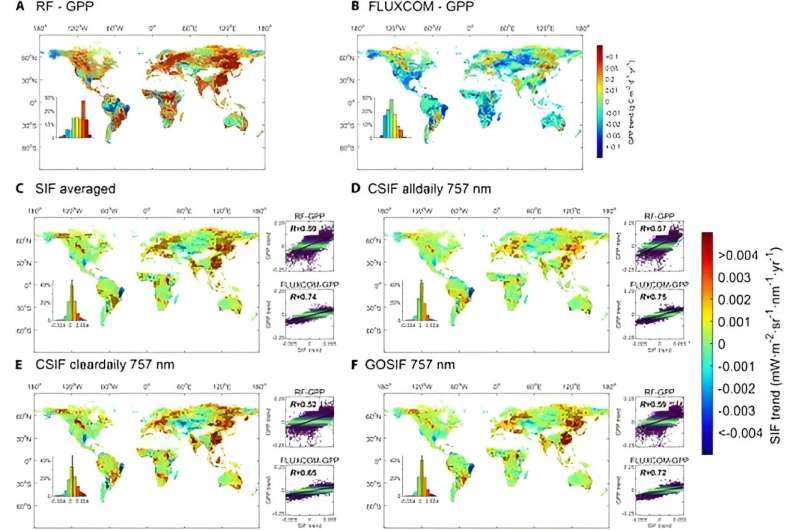This article has been reviewed according to Science X's editorial process and policies. Editors have highlighted the following attributes while ensuring the content's credibility:
fact-checked
proofread
Green light for accurate vegetation research: Evaluation of global SIF datasets

A recent study has pinpointed the top-performing solar-induced chlorophyll fluorescence (SIF) products for precise global monitoring of photosynthesis and vegetation dynamics. By thoroughly evaluating eight widely-used SIF datasets, the research team identified Global OCO-2 SIF (GOSIF) and Contiguous Solar-Induced Fluorescence (CSIF) as leading tools for estimating gross primary productivity (GPP) and forecasting key phenological stages.
These findings provide crucial direction for scientists aiming to enhance global vegetation monitoring and deepen our understanding of Earth's ecological processes, marking a significant leap in refining tools for tracking the planet's green pulse.
Vegetation is vital for climate regulation and ecological stability, yet global monitoring of its photosynthetic activity remains challenging. Traditional methods, relying on vegetation indices, often fail to capture the intricate dynamics of photosynthesis, especially under varying environmental conditions.
These challenges highlight the need for more direct indicators, such as solar-induced chlorophyll fluorescence (SIF), which offers a promising pathway for accurately tracking vegetation productivity and phenology on a global scale.
Conducted by Peking University and published in the Journal of Remote Sensing, this study offers a comprehensive evaluation of eight global SIF products. The research focuses on assessing these products' ability to estimate GPP and predict vegetation phenology.
Through meticulous comparisons with GPP datasets and phenological observations, the study reveals the strengths and limitations of each SIF product, providing valuable insights for remote sensing and global vegetation monitoring experts.
The study conducted a detailed analysis of eight SIF products derived from various satellite missions, including OCO-2, GOSAT, MetOp, and TROPOMI, each with unique spatiotemporal resolutions and inversion algorithms. By comparing these products against GPP datasets such as FLUXNET, FLUXCOM, and RF-GPP, the researchers identified GOSIF (757 nm) and CSIF datasets as superior in capturing the spatiotemporal variability of global GPP.
These datasets excelled particularly in representing the GPP of deciduous broadleaf forests, mixed forests, and evergreen needleleaf forests. The research also found that SIF products were more reliable in predicting the start of the growing season than the end or duration. This systematic evaluation underscores the importance of selecting appropriate SIF products for large-scale vegetation studies and lays the groundwork for future advancements in SIF data refinement.
Dr. Zaichun Zhu, the lead scientist of the study, says, "Our evaluation sets a comprehensive standard for selecting SIF products, improving the accuracy of vegetation monitoring and advancing ecological and climate research."
The findings from this study have wide-ranging applications in ecological monitoring, climate modeling, and environmental management. By identifying the most reliable SIF products for global GPP estimation, this research enhances the accuracy of vegetation productivity tracking, which is essential for understanding the carbon cycle and forecasting the effects of climate change.
Additionally, these insights provide a foundation for refining current SIF products and developing new ones, contributing to more precise and reliable tools for monitoring the health and function of ecosystems worldwide.
More information: Xuan Zheng et al, Characterization and Evaluation of Global Solar-Induced Chlorophyll Fluorescence Products: Estimation of Gross Primary Productivity and Phenology, Journal of Remote Sensing (2024). DOI: 10.34133/remotesensing.0173
Provided by Journal of Remote Sensing




















